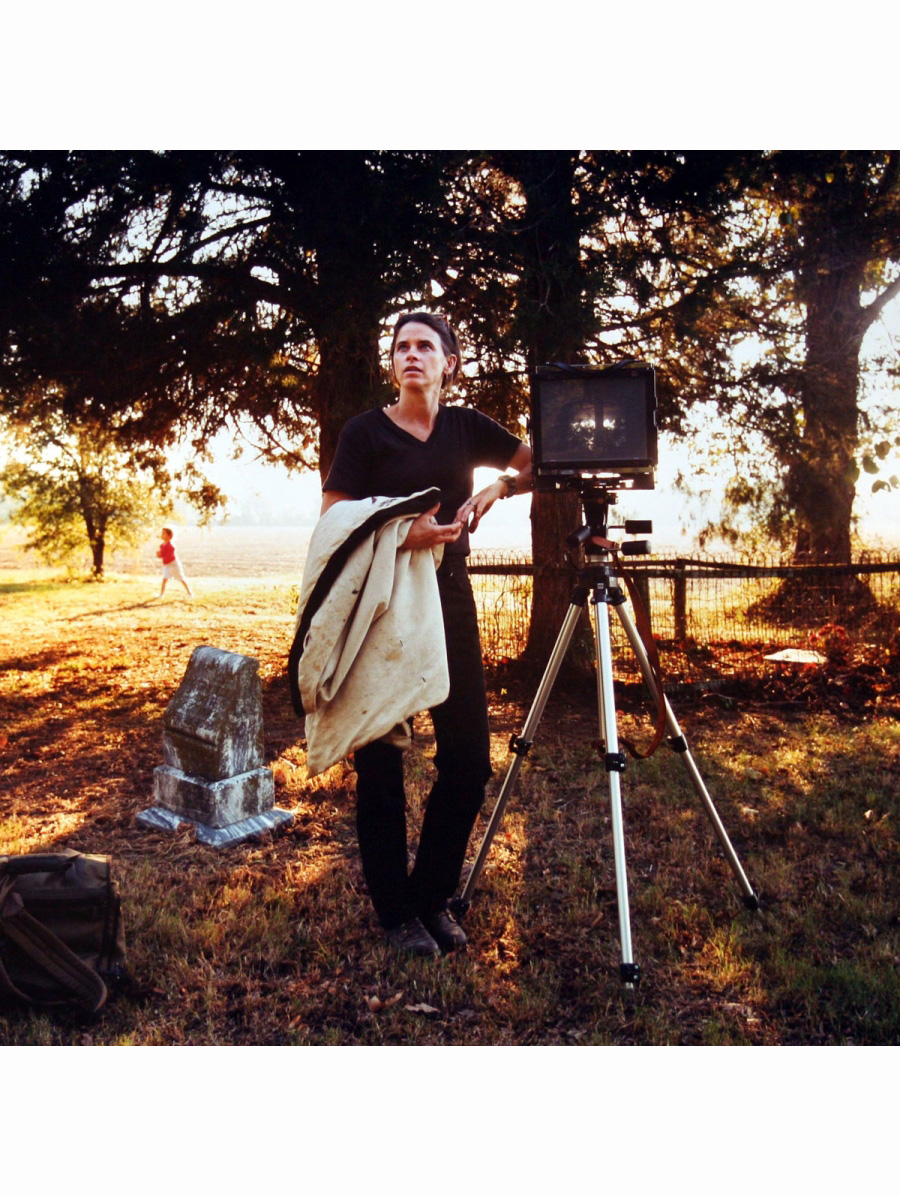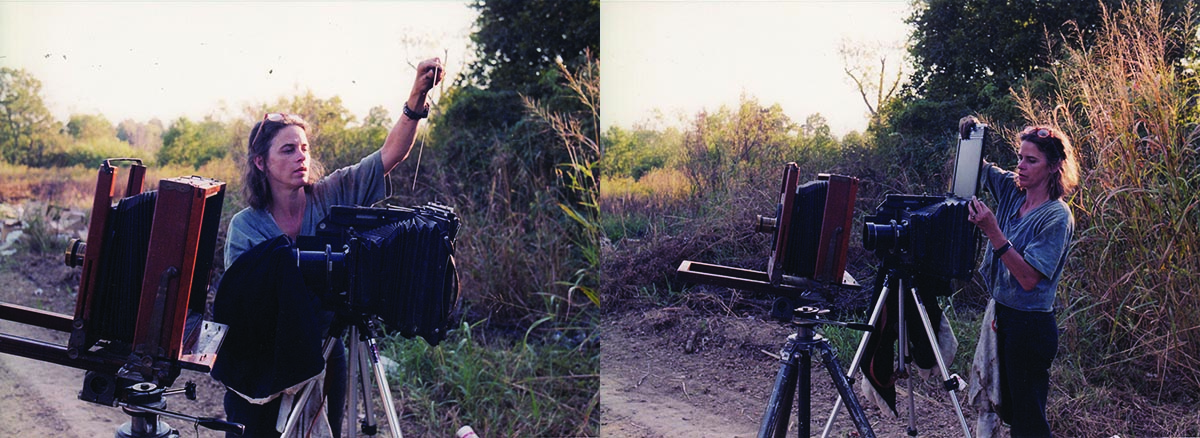SALLY MANN’S VISION
An interview with the photographer from 1999.
By Maude Schuyler Clay

Portrait of Sally Mann, 1999, by Maude Schuyler Clay
An interview from 1999, Issue 26.
At the end of the last century, Sally Mann, who had become known in the mid-1980s and early ’90s for making intimate portraits of her family’s life in rural Virginia, abruptly shifted her photographic subject matter and began shooting landscapes. In her memoir, Hold Still, she recounts those years in which she roamed the South alone in her Suburban, a mobile darkroom packed full with equipment and chemicals, stopping “whenever I saw something that felt like a photograph or held some mystery or happened to catch the light in an alluring way.” Mann’s memories and descriptions of the South are nearly as stunning as the photographs she produced; her intellectual and emotional faculties ever attuned and unassailable. Here is a dispatch from rural Mississippi:
As always, I picked the least traveled, most remote roads, exiguous pale blue lines on the map, certain in my bones of the memories residing there. Driving through those vine-hung dirt roads, the slender grasses on the verge bent with dust, I was improbably enough listening to Joseph Conrad’s Heart of Darkness on tape. Though a world apart from Africa, it was impossible for me not to think of the misery extracted at every turn in those roads, just as it had been impossible for Marlow to paddle up the Congo unaware of the “groves of death” lying within the shadows along the riverbank. For me, the Deep South was haunted by the souls of the millions of African Americans who built that part of the country with their hands and with the sweat and blood of their backs. I was moving among shades, aware, always, of their presence.
In this passage, Mann is traveling to Sumner and is haunted, particularly, by the presence (and lack thereof) of Emmett Till. As she notes: “Till’s murder was conspicuously unremarked upon” there. Fortunately, she had a local guide, who led her to the exact spot on the Tallahatchie River where Till's body was dumped by his murderers, and where she took a photograph: “There was, in fact, something mysterious about the spot; I could see it and feel it, and when I released the shutter I asked for forgiveness from Emmett Till.”
Her guide was the photographer Maude Schuyler Clay, who was then working in the art department of this magazine. Clay toured Mann around her postage stamp of native soil and, Mann remembers, “We chatted as we drove.” A short excerpt of these road conversations was presented in the Oxford American’s spring 1999 issue, along with a selection of previously unpublished color work from Mann’s family pictures period and new landscape images. The issue has sold out, but we present the interview below.
“I was lucky to have Maude,” Mann writes in Hold Still, recounting the emotional visit to Till’s unmarked vanishing place on the river. “She helped me carry my camera, bushwhacking a path alongside the cotton fields to the water’s edge, and I was glad for her company, feeling unusually vulnerable and alone.”
With the series of photographs you took of your children—some of them in the nude—you have been accused of exploiting children and promoting pornography. As a mother and assumed enemy of pornography, how do you address this dichotomy?
There is one absolutely inarguable statement you can make about those pictures: they testify to a maternal passion that is not only natural but pretty close to universally experienced. Anyone who finds it “dichotomous” that a mother should produce such saturatingly maternal images is beyond reasoning with.
How do you respond to people who criticize the National Endowment for the Arts for supporting “controversial” artists?
Do we want a society in which the only points of view that can command any attention are those which have institutional power behind them, those that have money behind them? Or do we want a society in which there is an open, robust, and pluralistic “marketplace of ideas,” to use the phrase so beloved of conservatives?
In case Senator Jesse Helms is listening, I will recall the words of St. Paul to the Corinthians: “There are, it may be, so many kinds of voices in the world, and none of them is without signification.”
Mark Strand has said about poetry that one of the reasons people read it is because they want to come into possession of a mystery. Do you think perhaps the reason people have responded to your work so strongly is because of its mysterious quality?
The creative act is mysterious in its essence. And every work of art confronts us with several layers of mystery, starting with some basic questions about the work’s relation to the world around it or to what it is representing. So we come away from any good work of art with a freshened sense of life’s mysteriousness. In a given case, the emphasis might be on, say, politics of wealth distribution, or it might be high ontology, way up there with Gauguin’s questions: where do we come from? what are we? where are we going? But whatever the emphasis, the heightened sense of mystery is always there.
I suppose one definition of propaganda (or pornography?) might be: art that denies the mysterious.
How did you decide to make the transition from highly charged, intimate family portraits to stark, unpeopled landscapes?
I said at the time of that transition that I’d been ambushed by my backgrounds, and I was, at that time, conspicuously vulnerable to ambush. The children got older, the apron strings came undone. In the later pictures, you can actually see them receding from my gaze.
Recently, I came across a quotation in José Donoso’s novel The Garden Next Door. A writer has spent the summer not writing, but sighing over the beautiful young woman in the garden outside his window. One day, she disappears. “But since the important thing about beautiful things is the pain of the deep wounds they leave, her presence in the garden may have been an obstacle for me; with her now gone, the empty park may be fruitful.”
My children as they were growing were hardly “obstacles” to my art. But the afterglow left when they went away allowed me to see the landscape as I couldn’t have seen it during the time my eyes were fixed on them.
In the movie Titanic, Leonardo DiCaprio’s character shows off a sketchbook of charcoal drawings. New York magazine suggested that three of the sketches greatly resembled the work of (1) Alfred Steiglitz, (2) Georgia O’Keeffe, and (3) Sally Mann. You reached an out-of-court settlement with the director James Cameron (who originally said the sketches were his). Did all this suggest that you had irretrievably entered the pantheon?
You can’t get much farther from any pantheon than James Cameron’s Titanic.
What kind of message do you think your work will have for future generations?
How do you make God laugh? runs the old joke. Answer: Tell Him your plans. The artist’s version of this joke might be: How do you make posterity laugh? Tell them what you think your work will mean in a hundred years.
In regard to your landscape photos, you said, “What I am trying to do is put a little affection back into photography.” Other than counterbalancing the history of men photographing their wives, what are you trying to do with your newest series, “Marital Trust,” which are intimate photos of you and your husband?
Photographing the commonplace and trying to make it new seems to have been my primary artistic intent. What could be more commonplace than the quotidian events within a three decade-old marriage?
In what ways, other than the fact that you grew up in the South, do you describe yourself as a “Southern Artist”?
Oh, the obsession with place, with family, with both the personal and the social past; the susceptibility to myth; the love of this light, which is all our own; and the readiness to experiment with dosages of romance that would be fatal to most late-twentieth-century artists. In that sense, Southern artists are like certain mountain religious folk, who in their devotions subject themselves to snakebites that would kill or disable anyone else. What snake venom is to them, romanticism is to the Southern artist: a terrible risk, and a ticket to transcendence.
One other very important matter, among white Southern artists, is the lifelong intimacy with African-Americans. I grew up with black people: few white American artists from outside the South can say that. I was raised, principally, by a black woman: however many historical demons stalked the relationship, I know with certitude that that woman loved me. Reynolds Price often draws attention to this aspect of the white Southern writer’s or artist’s experience and is right to do so. It is crucial.

Sally Mann making photographs in Mississippi; photos courtesy of Maude Schuyler Clay


